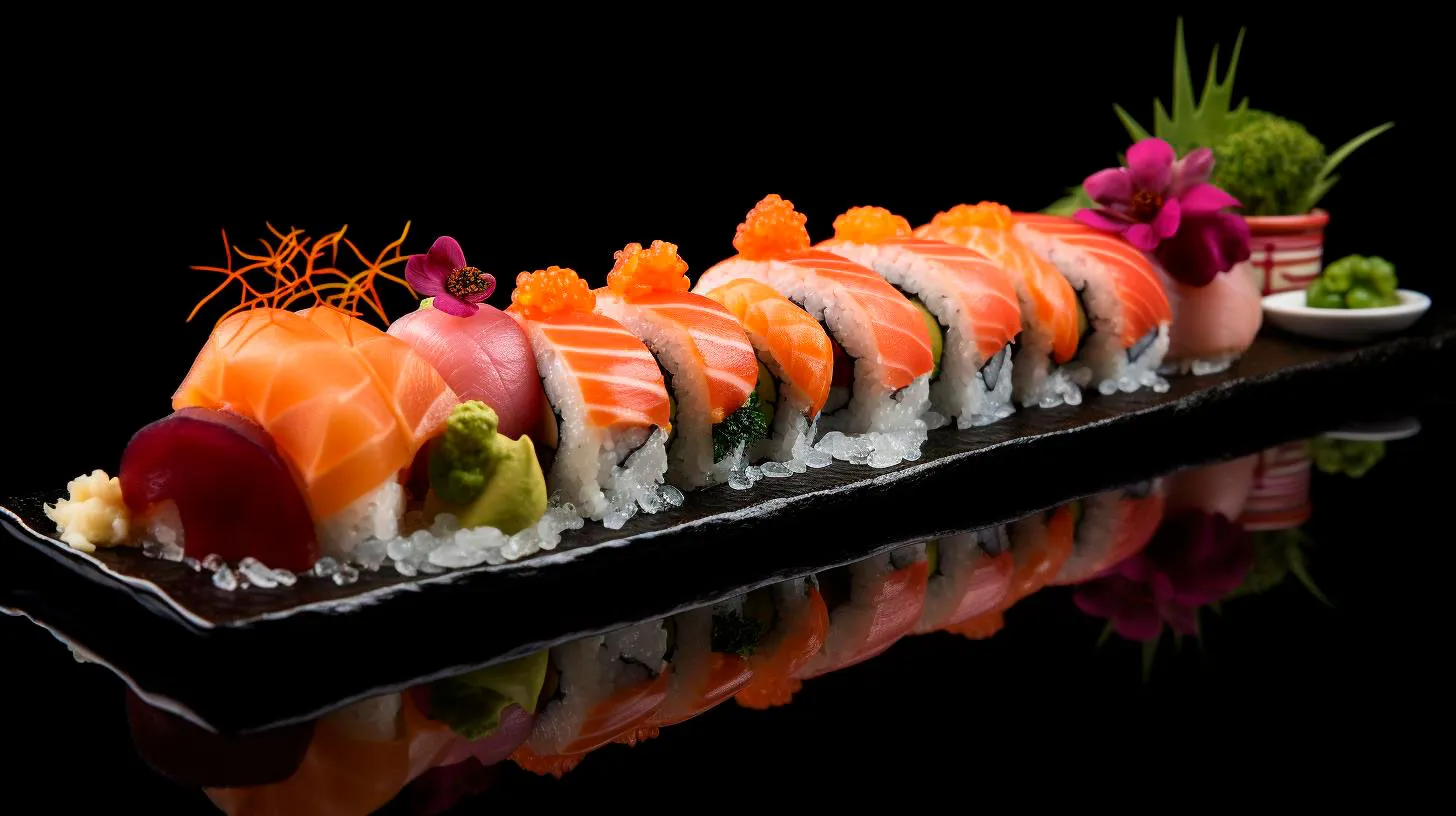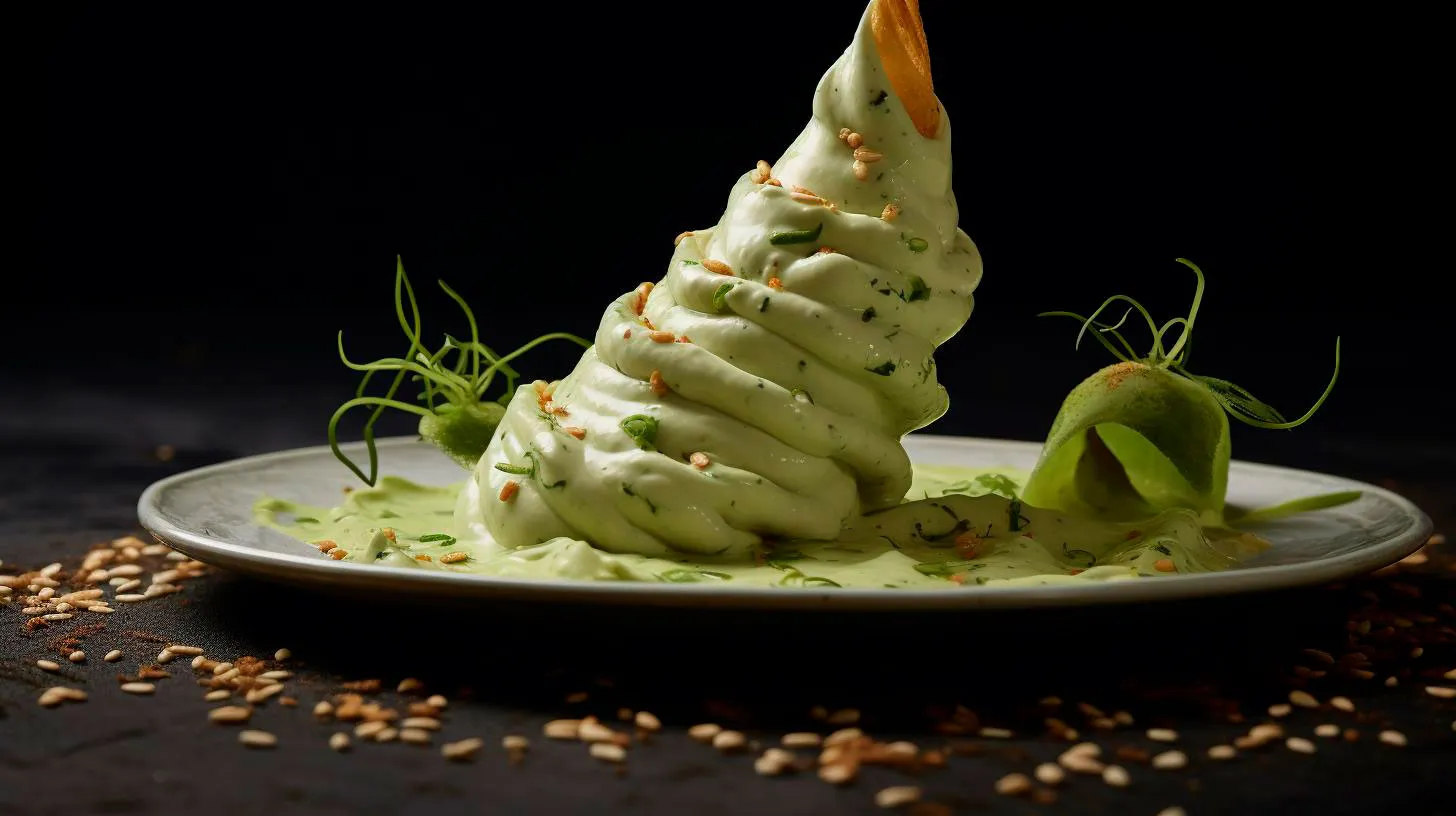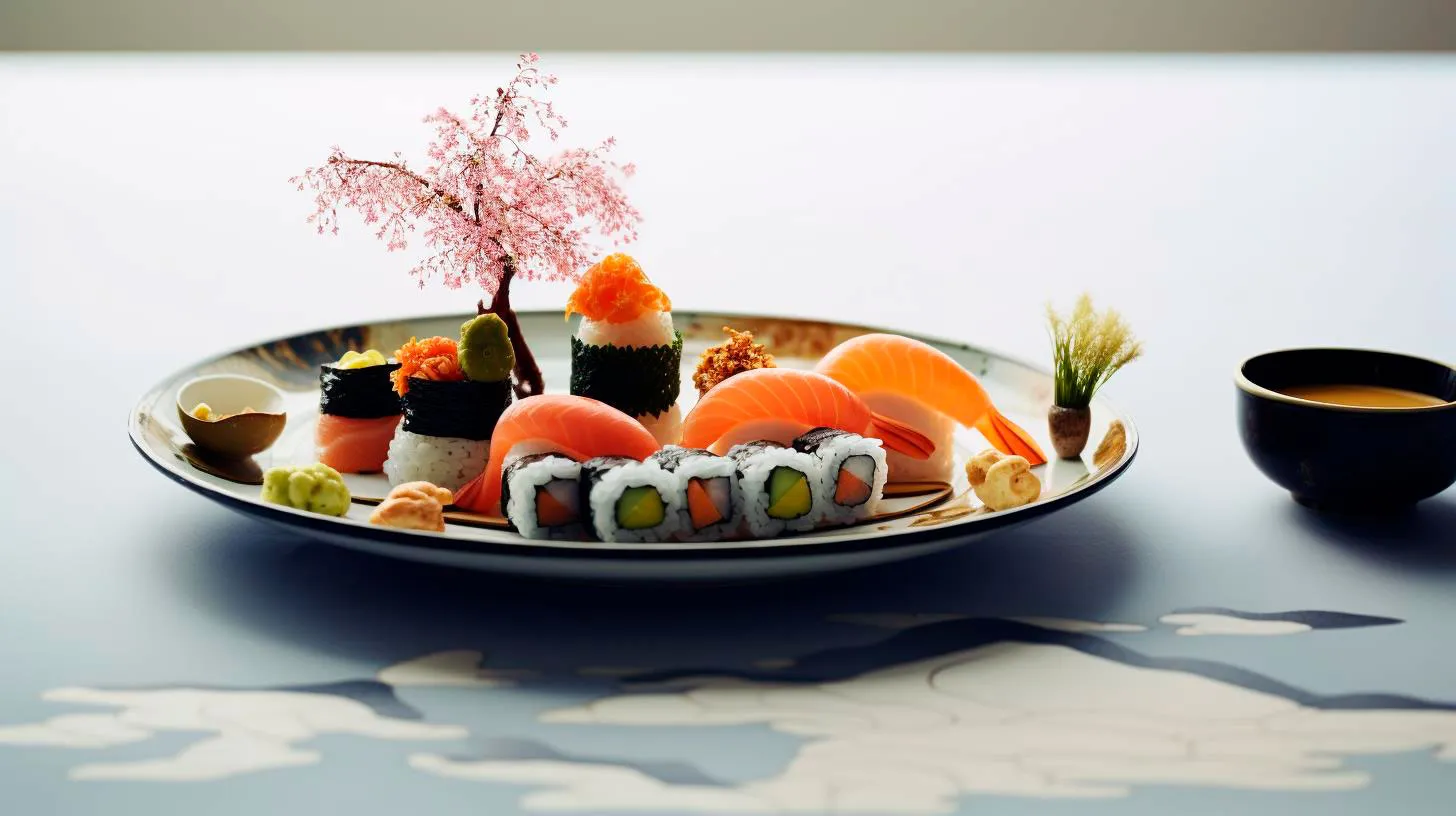Sushi Etiquette 101: Avoiding Loose Rice and Fish Bits Dilemma
This article will guide you through the dos and don’ts of sushi etiquette, so you can fully immerse yourself in this exquisite dining experience without embarrassing yourself or offending others.
The Art of Eating Sushi
Before we delve into the etiquettes, let’s briefly understand how to eat sushi properly. Each piece of sushi is carefully crafted, and it’s essential to devour it in the right way to fully experience its flavors and textures.
When served, sushi typically comes with soy sauce, pickled ginger, and wasabi. Here’s the correct way to enjoy sushi:
- Use chopsticks or your hands to pick up the sushi piece.
- Dip the fish (nigiri) into the soy sauce lightly, avoiding soaking the rice completely.
- If you prefer wasabi, dab a small amount directly on the fish or mix it into your soy sauce to create a dipping sauce.
- Avoid excessive soy sauce, as it may overpower the delicate flavors of the sushi.
- Place the entire piece of sushi in your mouth to savor the combined flavors of rice, fish, and any additional ingredients.
- Avoid biting the sushi in half, since it may cause rice and fish to fall apart, leading to a messy eating experience.
- Chef’s choice is best, so if you’re unsure about which sushi to order, trust the expertise of the sushi chef and opt for an omakase, or chef’s tasting menu.
Sushi Etiquette Dos and Don’ts
Mastering sushi etiquette not only shows respect for Japanese culture but also ensures an enjoyable dining experience for yourself and those around you.
Do: Respect the Sushi Chef
The sushi chef, or itamae, dedicates years of training to perfect the art of sushi-making. Show respect to the chef by following these etiquettes:
- When seated at the sushi bar, greet the chef with a polite “Kon’nichiwa” to establish a friendly atmosphere.
- Avoid asking for modifications unless you have dietary restrictions or allergies. Trust the chef’s expertise in creating balanced flavors.
- Refrain from distracting the chef with unnecessary conversation or gestures while they are working.
Don’t: Mix Wasabi and Soy Sauce
Mixing wasabi directly into the soy sauce is considered a faux pas in sushi etiquette. Doing so can lead to overpowering flavors that mask the subtle taste of the fish and rice. Instead, use wasabi sparingly and apply it directly to the fish or mix a small amount into the soy sauce dish separately.
Do: Use Chopsticks, Unless Instructed Otherwise
Using chopsticks is the traditional and accepted method of enjoying sushi. However, if the sushi chef indicates that it’s acceptable to eat with your hands, you may do so. If using your hands, pick up the sushi from the side, avoiding touching the fish directly.
Don’t: Leave Loose Rice or Fish Bits Behind
Leaving a mess behind is considered impolite. Ensure you consume the entire piece of sushi in one bite to avoid any rice or fish falling apart. If you find it challenging to fit the entire sushi piece in your mouth, politely ask the chef for a smaller, bite-sized piece.
Do: Enjoy Your Sushi Promptly
Sushi tastes best when consumed immediately. To appreciate the freshness and texture, eat the sushi promptly after it’s served. Avoid letting it sit on your plate for too long, as the rice may become dry and lose its intended flavor.
Key Takeaways
- Eating sushi properly enhances the overall dining experience.
- Use chopsticks or your hands to pick up sushi, dip the fish lightly in soy sauce, and avoid excess dipping.
- Respect the sushi chef and their expertise.
- Avoid mixing wasabi and soy sauce; use wasabi sparingly on the fish or in a separate dish.
- Consume the entire sushi piece in one bite to avoid loose rice or fish bits.
- Eat sushi promptly after it’s served to savor its freshness.
By following these sushi etiquette guidelines, you’ll ensure a pleasant and respectful dining experience. Remember, enjoying sushi is not just about the flavors—it’s about immersing yourself in a centuries-old culinary tradition where attention to detail and respect for the balance of flavors play a vital role.
Mastering Chopstick Techniques: Tackling Loose Rice and Fish Bits in Sushi
It’s not uncommon to find oneself struggling to pick up loose rice grains or slippery fish bits, especially when you’re new to chopstick handling. Fear not! In this article, we will explore some essential techniques to help you master chopsticks and gracefully tackle loose rice and fish bits in sushi.
Why Mastering Chopstick Techniques Matters
While you might be tempted to reach out for a fork, mastering chopstick techniques not only enhances your dining experience but also adds a unique cultural element. Additionally, using chopsticks correctly enables you to appreciate the delicate flavors and textures of each sushi bite, as well as maintain proper sushi etiquette. So let’s dive into the tips and tricks that will take your chopstick game to the next level.
1. Choosing the Right Chopsticks
The first step in mastering chopstick techniques starts with selecting the right chopsticks. Opt for chopsticks made of bamboo or wood, as they provide better grip and control. They are also lightweight and allow for better maneuverability. Avoid chopsticks with intricate designs or metal chopsticks, as they can be challenging to handle.
2. Mastering the Basic Grip
Getting a proper grip on the chopsticks is crucial for successfully handling loose rice and fish bits. Start by holding one chopstick with your thumb, index, and middle fingers, much like holding a pen. Next, place the other chopstick against the ring finger, allowing it to rest on the base of your thumb. Practice opening and closing the chopsticks repeatedly until you’re comfortable with the grip.
Key Takeaway:
- Select lightweight chopsticks made of bamboo or wood for better control.
- Hold one chopstick between your thumb, index, and middle fingers, and rest the other against the ring finger.
3. Finding the Proper Balance
Balance plays a crucial role in chopstick technique. Keep the bottom chopstick stationary, while using the top chopstick to do the moving. By maintaining this balance, you’ll be able to pick up small rice grains or fish bits effectively without dropping them. Remember, practice makes perfect, so don’t be discouraged if you’re initially not as accurate as you’d like to be.
4. Tackling Loose Rice Grains
Loose rice grains can be tricky to pick up, but with the right technique, it becomes a breeze. Using your thumb and index finger in conjunction with the chopsticks, gently but firmly press and squeeze the rice grains together. This will result in a compacted mound, making it easier to handle with the chopsticks. Lift the sushi piece with the compacted rice directly, using your chopsticks, to prevent any spillage.
Key Takeaway:
- Keep the bottom chopstick stationary and use the top chopstick to pick up loose rice grains.
- Use your thumb and index finger to press and squeeze the rice grains together, creating a compacted mound for easy handling.
5. Handling Slippery Fish Bits
When it comes to picking up slippery fish bits, precision is essential. While your grip might be similar to the one used for loose rice grains, the technique involves delicately balancing the slippery fish on top of the chopsticks. Apply a gentle amount of pressure to secure the fish and ensure it doesn’t slide off. With a controlled hand movement, lift the sushi piece to your mouth, keeping it intact.
Key Takeaway:
- Apply gentle pressure to secure slippery fish bits on top of your chopsticks.
- With controlled hand movements, lift the sushi piece to your mouth, ensuring the fish remains intact.
Conclusion
Mastering chopstick techniques is a valuable skill that not only enhances your sushi dining experience but also adds cultural flair. By selecting the right chopsticks, mastering the basic grip, finding the proper balance, and practicing techniques to tackle loose rice and slippery fish bits, you’ll soon become a pro in chopstick handling. Remember, practice is key, so don’t hesitate to enjoy sushi more often to refine your skills. With dedication and patience, you’ll be gracefully tackling loose rice and fish bits in no time!
Preventing Loose Rice and Fish Bits: Essential Etiquette for Sushi Lovers
One of the most important aspects of sushi etiquette is preventing loose rice and fish bits from falling apart. In this article, we will explore some essential techniques and practices to enhance your sushi dining experience and uphold proper sushi etiquette.
1. Choose the Right Grip
When it comes to sushi, using chopsticks is the most common and recommended utensil. Properly holding chopsticks ensures that your sushi remains intact and you don’t drop any rice or fish. Here are a few tips:
- Hold the chopsticks closer to the top, keeping them parallel to the table.
- Use your thumb and index finger to grip one stick, just like holding a pencil.
- Rest the other stick on your ring finger, applying slight pressure to hold it in place.
Practice using chopsticks regularly to improve your dexterity and grip, which ultimately leads to better control over sushi pieces.
2. Dip, Don’t Dunk
Dipping sushi into soy sauce is a common practice. However, submerging the entire piece can lead to loose rice and fish bits falling apart in the sauce. To prevent this, lightly dip the fish side (nigiri) or the end with condiments (maki) into the soy sauce. This way, you can savor the flavors without the risk of losing any ingredients or making a mess.
3. Eat in One Bite
Sushi pieces are typically prepared to be consumed in one bite. Taking smaller bites can result in rice crumbling and fish falling apart. Furthermore, eating sushi in one bite also allows you to enjoy the combination of flavors as intended by the chef. So, embrace the challenge and savor the entirety of each bite.
4. Use Ginger as a Palette Cleanser
Ginger slices, often served alongside sushi, are not meant to be eaten with your sushi directly. Instead, ginger serves as a palate cleanser between different types of sushi. Take a small piece after each sushi piece, gently bite into it, and swish it around your mouth to cleanse your palate before moving on to the next flavor. By doing this, you’ll fully appreciate the nuances of different sushi varieties.
5. Don’t Overload the Wasabi
Wasabi, a green paste made from Japanese horseradish, adds a unique and spicy kick to sushi. However, it’s important not to overload your sushi with wasabi. Sushi chefs usually apply the right amount of wasabi on each piece, so adding more can overpower the delicate balance of flavors. When in doubt, try a small amount first and adjust according to your preference.
Key Takeaways
- Using chopsticks correctly is crucial to prevent loose rice and fish bits.
- Dip sushi lightly into soy sauce instead of submerging the entire piece.
- Eating sushi in one bite helps maintain its integrity and enhances the flavors.
- Use ginger as a palate cleanser between different sushi pieces.
- Avoid overloading your sushi with wasabi and respect the chef’s original preparation.
Following these essential techniques will not only prevent rice and fish from falling apart but also show respect to the artistry that goes into crafting each sushi piece. By embracing the rich traditions and etiquette surrounding sushi, you’ll elevate your dining experience and fully appreciate the subtleties and flavors that this culinary delight has to offer.
Tips and Tricks for a Mess-Free Sushi Experience: Dealing with Loose Rice and Fish Bits
In this article, we will explore some handy tips and tricks to ensure a clean and hassle-free sushi experience.
The Challenge of Loose Rice and Fish Bits
When it comes to sushi, loose rice grains and fish bits can make a mess on your plate, your clothes, or even worse – your companions’ faces. These small yet stubborn particles have a tendency to stick to surfaces and make cleanup a challenging task. Here’s how you can tackle this issue effectively:
1. Master the Art of Chopstick Handling
Using chopsticks is an integral part of the sushi experience. Proper technique and control over your chopsticks can minimize the chances of rice grains falling off or fish bits slipping away. Here are a few tips:
- Hold the chopsticks slightly closer to the back end to attain better control.
- Practice using chopsticks regularly to improve your precision and agility.
- Gently rest your chopsticks on the plate or sushi tray when not in use to avoid contact with the table or other surfaces, preventing any contamination.
2. Embrace the Soy Sauce Saucer
One common point of messiness when enjoying sushi is dipping it in soy sauce. The soy sauce may splatter onto your plate or drip onto your clothes, leaving noticeable stains. Consider these tips to maintain a mess-free experience:
- Pour the soy sauce into the designated sauce saucer, ensuring it is not overfilled to avoid any spills.
- Dip the sushi briefly and place it on your plate with the fish side up to prevent any drips or splatters.
- Alternatively, use the back of your chopsticks to carefully apply a small amount of soy sauce directly onto the fish without dipping. This allows you to control the amount and avoid any mess.
3. Choose the Right Sushi Technique
The technique you use when consuming sushi plays a crucial role in preventing messes. Consider the following suggestions:
- Avoid biting sushi into two halves since this can cause fillings to spill out.
- Take smaller, more manageable bites to minimize the risk of rice grains falling.
- Hold the sushi piece with your fingers rather than the chopsticks when taking a bite. This can provide better control and prevent any mishaps.
Key Takeaways for a Mess-Free Sushi Experience
Here are some key takeaways to summarize our tips and tricks:
- Master the art of chopstick handling to maintain better control and prevent rice grains from falling.
- Embrace the use of a soy sauce saucer to prevent spills and stains.
- Choose the right sushi technique to avoid fillings from spilling and rice grains from falling.
Sushi is not only a culinary delight but also an experience that engages your senses. By implementing these simple yet effective tips and tricks, you can elevate your sushi experience while keeping it mess-free. Now you can savor every delicious bite without worrying about loose rice or fish bits tarnishing your enjoyment.
Makes sure to apply these tips next time you indulge in this delightful delicacy. Happy sushi eating!



